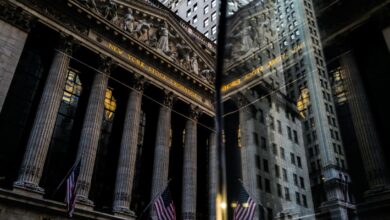What History Tells Us About the Fed’s Next Move

The Federal Reserve will make a decision on interest rates this week against a very different backdrop than a few months ago, or even a few days ago.
Amid new data showing that inflation remains stubborn, financial markets are rapidly paring back their expectations for interest rate cuts this year. Bond futures traders started 2024 believing there’d be six cuts in total, with the first coming as early as March. Three months of hotter-than-anticipated Consumer Price Index data pushed the predicted timing of the first cut to summer and reduced the year’s total number of cuts to three.
This past week, new data showed an unfortunate double whammy for markets: slowing gross domestic product growth and an unexpectedly high reading on the Personal Consumption Expenditures Price Index, the Fed’s preferred measure of inflation. Now investors are bracing for the possibility that the first interest rate cut won’t come until the fall, or even as late as December. Or maybe not until next year.
Through the fall of 2023, stock and bond markets soared amid growing optimism that the central bank might achieve a perfect soft landing and be able to cut rates. Inflation was slowing, the economy was growing, and the labor market remained resilient. But now, with progress on inflation appearing to stall out, the fate of the economy (and the outlook for rate cuts) is looking more complicated.
Thursday’s GDP data “definitely throws a wrench in the Goldilocks scenario,” says James Ragan, director of wealth management research at DA Davidson. “The combination of slowing growth and higher inflation is not the ideal outcome.”
What to Expect from the May Fed Meeting
For Sam Rines, macro strategist at WisdomTree, the Fed’s May meeting will be “more of the same,” and that’s not necessarily a bad thing. “I think the FOMC is going to be very happy about the current pricing because it gives them optionality,” he explains.
Bond futures markets are 97% certain that the central bank will hold rates steady at its target range of 5.25%-5.50% next week, according to the CME FedWatch tool. The Fed is set to announce its next decision on interest rates Wednesday at 2 p.m. EDT.
The Fed has consistently asserted that it needs “more confidence” that inflation is improving before it considers easing policy. So far, “there’s very little to no data that has provided them additional confidence,” Rines says. The goal of the May meeting is to maintain the option to cut rates if economic conditions warrant the move, he adds, “but also maintain the expectation that they’re not going to cut significantly, at least until the end of 2024 and into 2025.”
PCE data released Friday which showed price pressures stayed firm in March didn’t improve the picture. “Today’s data means that it will take a longer string of months of good inflation data before the Fed will be comfortable with cutting,” says Preston Caldwell, chief US economist at Morningstar. That holding pattern has market watchers drawing comparisons to the central bank’s 1995 easing cycle. Here’s what investors can and can’t learn from the historical playbook.
Is It 1995 All Over Again?
“The comparison is certainly appropriate,” says Jim Caron, CIO of the portfolio solutions group at Morgan Stanley Investment Management. “The Fed hiked rates a lot starting from a very low base” in 1994, he explains. The central bank then held rates steady until the middle of 1995. A few interim cuts that year gave way to another long holding period, and then it hiked again in 1997. The next cutting cycle began in the fall of 1998.
At the onset of the hiking cycle, markets “immediately projected negatively that the Fed would just raise rates indiscriminately” and push the economy into recession, says John Stoltzfus, chief investment strategist at Oppenheimer Investment Management. “The market went down, the bears were the loudest voices you could hear.” But markets recovered, and the Fed’s tighter policy didn’t dent the decade’s booming economy.
Another reason this cycle resonates today is that it “was the only time when the Fed went on a rate-cutting cycle and there was no recession,” Ragan adds.
2024′s Rate Landscape Is Unique
Despite its similarities to the current moment, analysts say the 1995 cycle isn’t a perfect analogue.
“The problem with this type of historical comparison is that the catalysts in the events were completely different at the time,” Caron explains. The inflation saga of the past two years is historically unique, spurred by a once-in-a-generation pandemic and a massive infusion of cash into the economy from the federal government.
Adds Rines: “It’s a different economy, it’s a different inflation shock.” Back then, with GDP growth slowing and inflation fairly steady, “the Fed had room to tweak around and find normal rates. It wasn’t going to cost it anything to tweak by a quarter point here and there.” But today, quarter-point calibrations would come with a significantly higher cost. Analysts say the central bank can’t risk sending inflation higher if it cuts too soon, not to mention how any unexpected moves could make waves in financial markets.
Bottom Line for Investors
Even if looking back to 1995 can’t tell us exactly what to expect from the Fed in 2024, Caron thinks investors can still take one lesson to heart: “It’s not uncharacteristic for [the Fed] to take longer and be on hold for an extended period, with minor adjustments until they get what they want. In other words, a year without rate cuts wouldn’t be unheard of.
Sticky inflation shouldn’t worry the long-term investor all that much, either. “This is not uncommon in periods when the Federal Reserve has been taking action against inflation for a while and has achieved considerable success,” says Stoltzfus.
“The market has performed very well with rising interest rates,” Rines adds. “Inflation has come down, it just needs to come down more. And then the Fed will normalize rates … and we will continue to have an economy that grows.”





